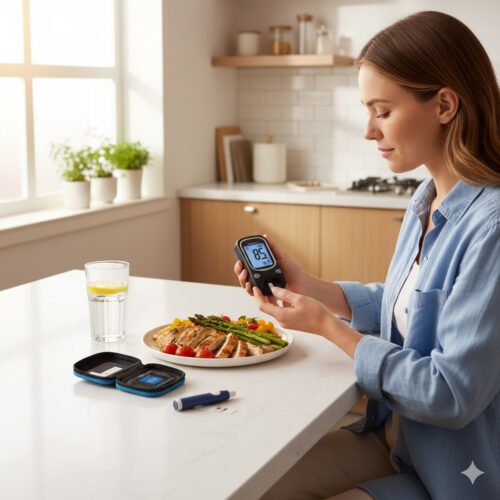High blood sugar can feel frightening, especially if it happens suddenly or you’re not sure what to do. The good news is that there are safe and effective steps you can take at home to help bring your levels down naturally. Simple actions—like staying hydrated, moving your body, and eating the right foods—can make a big difference in how you feel.
This guide shares clear, science-backed steps you can start using today. Each tip is easy to follow, practical for daily life, and designed to help you feel more in control of your health. Whether you’re managing diabetes or just want to balance your blood sugar, you’ll find friendly guidance here that truly works.
What is high blood sugar (hyperglycemia)? — quick explanation
High blood sugar means there is too much sugar (glucose) in your bloodstream, and your body isn’t using it properly for energy. This happens when your insulin levels are too low or your cells resist insulin’s effects. Common triggers include missing your diabetes medicine, eating too many carbs or sugary foods, being sick, or feeling stressed for long periods. When your blood sugar stays high, you might notice warning signs like feeling very thirsty, peeing more often, blurry vision, tiredness, dry mouth, or headaches.
If high blood sugar lasts too long, it can harm your heart, kidneys, eyes, and nerves over time. That’s why it’s important to recognize the symptoms early and take action right away. (Source: NHS)
First things first: check your blood sugar and stay calm
Test your glucose if you can. A quick reading gives you a clear picture of what’s happening inside your body and helps you decide your next step. Knowing your number helps you tell if it’s a mild rise that you can manage at home or if you need medical help. Always write down your results so you can track patterns and share them with your doctor later. (Source: diabetes.org)
Stay calm. Feeling anxious can actually make your blood sugar climb even higher. When you’re stressed, your body releases hormones like cortisol and adrenaline, which raise glucose levels. Try taking slow, deep breaths for one full minute. You can also sit down, relax your shoulders, and focus on breathing in through your nose and out through your mouth. A calm mind helps your body recover faster.
Look for danger signs. If you feel very weak, confused, dizzy, have deep or rapid breathing, nausea, or vomiting, these could be warning signs of something serious—especially if your reading is very high (for example, over 240 mg/dL). Don’t wait. Call your healthcare team or emergency services right away. These symptoms can point to diabetic ketoacidosis, a condition that needs urgent treatment. (Source: Mayo Clinic)
Quick, safe ways to lower blood sugar at home (what to do now)
Use the tips below based on your situation. If you use insulin or other diabetes medicines, follow your care plan first.
1. Drink water — hydrate to help your body flush sugar

Drinking water is one of the fastest and safest ways to help lower blood sugar at home. When your sugar levels are high, your kidneys work harder to filter and remove the extra glucose from your blood. Staying well-hydrated supports this natural process by helping your body flush out the excess sugar through urine. Try sipping small amounts of water throughout the day instead of drinking a large amount all at once. Aim for at least 8 glasses daily, or more if you’re active or live in a hot climate.
Avoid sugary drinks like soda, fruit juice, or energy drinks, as they can cause your blood sugar to rise even higher. Instead, choose plain water, sparkling water, or unsweetened herbal tea. You can also add a slice of lemon or cucumber for flavor. Keeping your body hydrated not only helps control blood sugar but also supports better digestion, energy, and overall health. (Mayo Clinic)
2. Move your body — light activity helps use glucose

Physical movement is one of the most effective ways to help lower blood sugar naturally. When you move your body, your muscles use glucose for energy, which helps bring down high sugar levels. You don’t need a tough workout—even a short walk after a meal can make a big difference. Try walking for 10–20 minutes at a comfortable pace, or do gentle activities like stretching, light yoga, or slow dancing.
These small movements help your body process sugar more efficiently and improve insulin sensitivity over time. If you make it a daily habit, you’ll notice steadier blood sugar levels and better energy throughout the day.
However, be cautious if your blood sugar is very high (for example, over 240 mg/dL) and you have ketones in your urine. In that case, avoid intense exercise—it can actually raise your sugar even more and make you feel worse. Always check your levels first and listen to your body. If you’re unsure, it’s best to contact your healthcare provider for guidance before exercising. (Health)
3. Take your diabetes medicine as prescribed
Your medication plays a key role in keeping your blood sugar within a healthy range. Always take your diabetes medicine exactly as your doctor has instructed. These medicines work in different ways—some help your body make more insulin, while others help it use insulin better or slow down how sugar enters your bloodstream. Skipping doses or taking extra medicine can cause your blood sugar to swing too high or too low.
If you realize you missed a dose, check your care plan or instructions from your doctor. Some medicines can be taken later, while others should be skipped if it’s too close to your next dose. Never double up to “catch up,” as that can lead to dangerous drops in blood sugar.
If you use insulin and aren’t sure what to do, call your care team right away for advice. They can guide you on how to adjust safely. Keeping a written medication schedule or using a reminder app can also help you stay on track. Taking your medicine properly, along with healthy habits, helps you manage your blood sugar more effectively and prevent long-term complications. (CDC)
4. Eat smart right now — choose low-glycemic foods

When your blood sugar is high, it’s important to eat foods that won’t make it rise even more. The best way to do this is by choosing low-glycemic foods, which digest slowly and keep your blood sugar steady. These foods give your body energy without sudden spikes or crashes.
If you’re feeling hungry, start with non-starchy vegetables like salads, spinach, broccoli, cucumbers, or bell peppers. These are packed with fiber, vitamins, and minerals that support blood sugar balance. Add a small portion of lean protein such as an egg, grilled chicken, fish, or tofu. Protein helps you feel full longer and slows the release of sugar into your bloodstream.
A handful of nuts or seeds—like almonds, walnuts, chia, or sunflower seeds—can also help. They contain healthy fats that support heart health and help control cravings.
Avoid foods that quickly raise blood sugar, such as sweets, sugary drinks, white bread, crackers, and pastries. These are high in refined carbs and can cause sharp glucose spikes. Instead, focus on whole, natural foods that keep your energy level stable and your blood sugar under control. Making smarter food choices now will help your body recover faster and feel better. (diabetes.org)
5. Follow “sick day rules” if you are unwell
When you’re sick, your body releases stress hormones to help fight the illness. Unfortunately, these same hormones can make your blood sugar rise, even if you’re eating less than usual. That’s why it’s important to follow your diabetes sick-day plan whenever you’re not feeling well.
Start by testing your blood sugar more often—every few hours or as your care team recommends. This helps you see how your illness is affecting your glucose levels and whether you need to adjust your medicine or food intake. Stay well-hydrated by drinking plenty of water, sugar-free drinks, or clear broth to prevent dehydration. Fluids help flush extra sugar from your system and keep your kidneys working properly.
Keep taking your prescribed medicines unless your doctor advises otherwise. Even if you’re not eating much, your blood sugar can still rise during illness. If you take insulin, you may need to adjust your dose based on your readings—always check with your care team first before making changes.
If you can’t keep food or fluids down, or you start vomiting, have diarrhea, or see very high readings that won’t go down, contact your healthcare provider right away. They can guide you on what to do next to stay safe. Having a clear plan for sick days helps prevent serious complications like dehydration or diabetic ketoacidosis. (nhs.uk)
Safe tips to avoid making things worse
- Don’t exercise hard if you have ketones or very high sugar. Exercise can raise sugar in that case. Test urine for ketones if you have type 1 and feel ill. (Mayo Clinic)
- Don’t skip medicine or double up without advice. Changing doses can cause dangerous lows or highs. (CDC)
- Avoid sugary “quick fixes” that add more carbs if your goal is to lower sugar. (Quick carbs are for low blood sugar, not high.) (diabetes.org)
Practical plan: what to do step-by-step if your blood sugar is high
- Test your blood glucose. Write the number down. (diabetes.org)
- Drink water—1–2 cups slowly. (Mayo Clinic)
- Move gently—walk 10–20 minutes if no ketones and you feel OK. (Health)
- Eat a low-GI snack only if needed; avoid extra carbs. (diabetes.org)
- Take meds exactly as prescribed. Contact provider if you missed doses or if sugar stays high. (CDC)
- Re-test in 1–2 hours. If no improvement or numbers are dangerously high, call your health care provider or go to emergency. (Mayo Clinic)
Foods and drinks that help long-term (and which to avoid)
Good to include regularly
- Water and herbal teas. (Mayo Clinic)
- Non-starchy vegetables. (diabetes.org)
- Lean protein, healthy fats (fish, nuts). (diabetes.org)
- Whole grains and legumes in controlled portions.
Limit or avoid
- Sugary drinks, sweets, pastries. (diabetes.org)
- White bread, white rice, and other refined carbs. (diabetes.org)
Lifestyle habits that keep blood sugar steady
- Move daily. Regular activity helps your body use glucose better. Even short walks after meals can help. (Health)
- Eat regular, balanced meals. Use a plate method: half non-starchy veg, quarter protein, quarter carbs. (diabetes.org)
- Manage stress. Stress hormones raise blood sugar. Try breathing, short walks, or calling a friend. (nhs.uk)
- Sleep well. Poor sleep makes blood sugar control harder. Aim for consistent sleep times. (Mayo Clinic)
When to get urgent medical help — clear red flags
Call your healthcare team or emergency services if any of these happen:
- You can’t keep fluids down or you have ongoing vomiting. (Mayo Clinic)
- Your blood sugar stays above 240 mg/dL and you have positive ketones (type 1). (Mayo Clinic)
- You feel confused, extremely drowsy, or have trouble breathing. (nnuh.nhs.uk)
Tools that make home care easier
- A reliable glucose meter and strips. Test often when levels are unstable. (diabetes.org)
- A water bottle to track fluids. (Mayo Clinic)
- A walking plan (short walks after meals). (Health)
- A written “sick day” plan from your healthcare team. It helps you act fast when you’re unwell. (nhs.uk)
Helpful, trusted resources (learn more)
- American Diabetes Association — hyperglycemia and managing blood sugar. (diabetes.org)
- Centers for Disease Control and Prevention — managing diabetes day to day. (CDC)
- Mayo Clinic — what to do for high blood sugar and when to seek help. (Mayo Clinic)
- NHS — clear guidance on high blood sugar, symptoms, and actions. (nhs.uk)
Quick FAQ — short answers
Q: Can I lower blood sugar fast without medicine?
A: Yes — hydrate, move (lightly), and eat low-GI foods. But if you need medicine to control it, follow your plan or contact your provider. (Mayo Clinic)
Q: Should I drink fruit juice to lower high sugar?
A: No. Fruit juice raises sugar. Juice is for treating low blood sugar, not high. (diabetes.org)
Q: How often should I test when my sugar is high?
A: Test more often — every 1–2 hours if you can — and follow your care plan. (diabetes.org)
Conclusion — you’re not alone, you can act now
High blood sugar can feel scary, especially if it happens suddenly or you’re not sure what’s causing it. But the good news is, there are simple and effective things you can do at home to help bring your levels down safely. Start by testing your blood sugar to know where you stand. Then, drink plenty of water to help your body flush out extra glucose. Move your body gently—like taking a short walk—to help your muscles use up sugar for energy. And most importantly, follow your treatment plan just as your doctor recommends.
Use the trusted links above to learn more about how to manage your blood sugar and what steps to take if it happens again. If your levels don’t go down or you notice red-flag symptoms such as extreme tiredness, confusion, vomiting, or trouble breathing, get medical help right away. Acting quickly can prevent serious problems.
Now it’s your turn—which tip will you t



